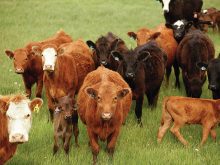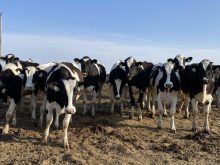In a year with significant drought issues in many parts of Western Canada and limited pasture, early weaning can be a management tactic that might prove beneficial in some situations.
Dry cows have lower nutritional requirements than lactating cows and therefore may be able to improve in body weight and body condition score if their calves are weaned early. This can affect reproductive efficiency of the cow herd in the subsequent breeding season as body condition is maintained within the herd.
The challenge often lies with how to deal with the lighter weight calves. If the cow-calf producer has available feed sources, calves can be backgrounded quite successfully at home or they can also be marketed to feedlots in some circumstances.
Read Also

Beef check-off collection system aligns across the country
A single and aligned check-off collection system based on where producers live makes the system equal said Chad Ross, Saskatchewan Cattle Association chair.
There has been a great deal of research published on fetal programming in beef cattle. Much of this research shows the nutritional status of the cow during pregnancy can have a major impact on the subsequent performance of the calf that the cow is carrying. Some research shows poor nutrition during gestation can affect growth of the placenta and subsequently affect the growth of the calf and even its carcass composition.
A recent paper in the journal Translational Animal Science tried to assess if early weaning might have any positive implications in terms of the performance of the calf in the subsequent calving season. That is, if early weaning is carried out in the cow herd, does the improved nutritional status of the cows that are early weaned provide benefits to the fetus that they are carrying, and can these benefits be demonstrated in the performance of the next calf crop?
The researchers from the University of Illinois used 146 mature Simmental X Angus cows for this experiment. Cows were randomized into one of two treatments. One group of cows were assigned to an early weaning treatment where their calves were weaned on average at about three months of age and the other group of cows had their calves weaned at a more traditional time of about six months of age.
As expected, cows in the early weaning group had significantly higher body weights and better body condition scores and this body condition score difference persisted throughout the entire subsequent lactation period. This is largely because the conventionally weaned cows had higher nutritional requirements during early gestation as they were still lactating. During the first three months of the trial, these cows lost body weight and body condition scores. Despite these body condition score differences, there were no differences observed in artificial insemination pregnancy success or overall pregnancy success in the subsequent year.
This study was probably too small to detect major differences in these types of outcomes. Other studies that examined early weaning of cows in the past have shown significant improvements in subsequent in conception rates. However, many of those differences have been demonstrated in first- and second-parity cows and this study only used mature cows. In this study, the body condition score of the early weaned cows was 5.3 out of 9 at the time of AI, compared to a body condition score of 4.9 in the conventionally weaned cows.
There was no difference in gestation length between the two treatment groups. However, the calf birth weights were significantly greater by about two kilograms in the calves from cows that had gone through early weaning in the previous year. This suggests the improvement in nutritional status for these cows had some effects on placental growth and fetal development. Despite the greater birth weights, there was no difference in weaning weights or feedlot performance between the two groups of calves that were subsequently weaned from these two groups of cows.
This recent research demonstrates again some of the benefits of early weaning in situations where nutritional resources are limited. The body weight and body condition scores of cows that underwent early weaning improved from the time of breeding throughout the next lactation. Although these improvements did not result in improved reproductive performance in the cows in this study, they might be expected in a larger study that included younger cows. In addition, birth weight of the calves born in the next calving season was improved, suggesting some potential benefits to the fetus during gestation. However, these benefits did not translate into improved pre-weaning or post weaning performance in the calves born in the subsequent breeding season.
If your forage resources are limited this year due to drought, you may want to consider early weaning in your herd as a management tactic. Discuss the plan with your nutritionist, veterinarian and livestock specialist to develop a strategy that might work best in your situation.
John Campbell is a professor in the department of Large Animal Clinical Sciences at the University of Saskatchewan’s Western College of Veterinary Medicine.

















